The destruction and corruption of ancient wonders have always felt like an arrow through my heart. The fabled wonder of the Library at Alexandra, dedicated to the Muses and center to the scholars of the world, was ransacked and burned in one of the most symbolic destructions of cultural knowledge. The historic tombs, crypts, and pyramids of the Ancient Egyptians, with artistic renderings and loving gifts to the dead, were raided by grave robbers who gave no regard to the cultural location’s sanctity. I hold grudges against people’s wanton carnage of anything historical, yet standing at the doorway to the excavation of Ancient Akroteri exposed me to a new perspective of ruins created by Mother Nature.
Immediately after I walked into the climate controlled excavation site, I stood there for a good three minutes speechless, with my jaw dropped and tears in my eyes. It’s an indescribable feeling to stand there amidst an ancient 4000-year-old city that half preserved and half destroyed by a volcano. The Minoan eruption responsible for this carnage occurred in five phases, the first of which partially preserved Ancient Akroteri (1). More information can be found in Carly Stefano’s summary of the eruption, A Geologic Lesson for the Little Ones.
Before the Minoan eruption, Santorini volcano had a gas-rich and viscous magma chamber. When a gas-rich magma rises to the surface the gases come out of solution to form bubbles in the magma. If they do so quickly, pumice— a light, frothy rock full of many irregular holes, forms and is projected out of the volcano for kilometers. This pumice, along with ash and small lithic fragments (broken parts of the volcano at the vent) landed in the city of Ancient Akroteri and started to fill crevices and structures in a massive blanket of material averaging 80 cm thick (1).
As this eruption continued, and more of the vent was being broken and flung away, water started to seep into the vent on the island volcano and the Minoan eruption moved into Phase 2. Water acted as a catalyst as it sped up the eruptive processes already occurring. The mix of gas, pumice, ash, and lithic fragments built up and started to boil over the volcanic rim similar to froth in a boiling pot of spaghetti. This cloudy mix is sent out in waves called pyroclastic surges.
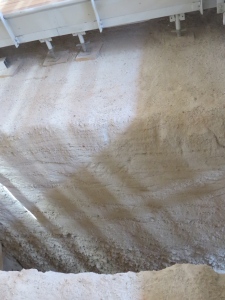
Clouds of ash and pumice are gas supported as they glide across the landscape. The gas medium causes the surge to behave erratically and flow down, up, and over topographic highs and lows. The particles inside the cloud are rolling, causing the surges to move turbulently. This turbulent flow creates a wave, with troughs and crests, and the wavelength of the surge is preserved in its deposits.

In addition to the creation of pyroclastic surges, water entering the vent causes the volcano to be more excavational. Larger pieces of the volcano are being torn off and heaved into the air as “blocks”. The eruptive power of the volcano sends these blocks hundreds to thousands of meters away. On Santorini, blocks have been unearthed in Ancient Akroteri, 5.5 kilometers away from the vent.
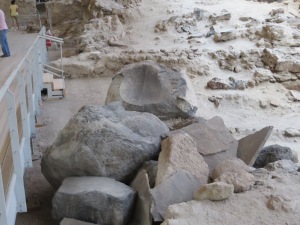
The mix of surges and blocks pummeled the upper levels of Ancient Akroteri which were not already buried in the pumice of Phase 1. The surges rolled over the city much like the waves created from nuclear detonations. The blocks land at great speeds and destroy anything they impact. Walking through Akroteri I could see the waves of Phase 2 in the walls that have not been excavated and observed blocks 1-2 m wide littering the streets and damaging the walls. It’s terrifying to realize you are standing in a spot that was buried by such prodigiously destructive forces.
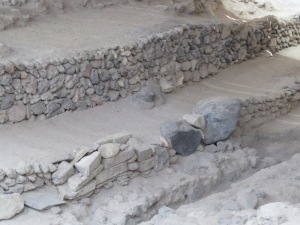
When I think about the Library of Alexandria and the Pyramids of Egypt my heart is heavy and I am filled with a sense of wrongness, but it is a different perception when it comes to Ancient Akroteri. This wealthy society was architecturally and agriculturally advanced, with luxuries such as indoor plumbing, market places, and imported tiles. The preservation of what this civilization created was an act of salvation by Mother Nature, who simultaneously removed Ancient Akroteri from the face of the Earth. Living on Santorini’s largest island, you can’t help but to fall in love with the caldera view and geologic setting of the island created by its volcanic activity. This landscape is a result of the Minoan eruption that both created the amphitheater-shaped islands surrounding an active, resurgent volcano, and preserved Ancient Akrotiri’s haunting beauty in the ash covered, ethereal ruins.
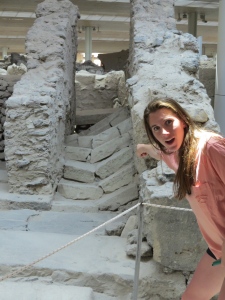
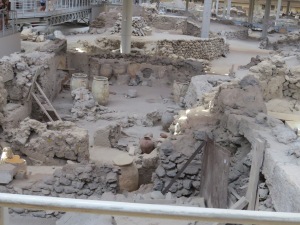
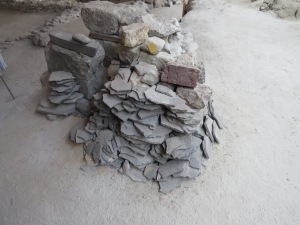
Druitt, T.H. 2014, New Insights Into the Initiation and Venting of the Bronze-Age Eruption of Santorini (Greece), from Component Analysis. Bull Volcanology, 76:794.

Alex,
What a great topic! It was a very interesting read and your introduction and conclusion were very passionate and gripping. It is obvious you care deeply about this subject and it definitely benefited your post.
I agree with Scott – you did a great job of conveying your passion and excitement for the preservation and destruction of Akroteri, while at the same time breaking down the complex forces responsible for it. Excellent figures and figure captions.
Hi Alex,
I was just reading about the Ancient Library of Alexandria, and I too was upset by senseless human destruction. What is fascinating when we look at ancient history is that reasons for destruction are manifold, and that we often don’t know for sure what actually happened and why it happened. With Arkoteri, we know what happened, and we know that humans were not the reason for the destruction. I wonder whether this knowledge changes how we perceive a specific site, and how we make sense of what happened.
It was very nice to see that you referenced Carly’s blog entry. It creates a sense of community among all of you that is difficult to achieve in traditional class settings. Nice work.